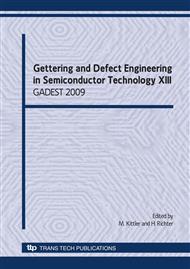p.173
p.181
p.187
p.193
p.199
p.205
p.211
p.217
p.223
Molecular Simulation on Interfacial Structure and Gettering Efficiency of Si (110)/(100) Directly Bonded Hybrid Crystal Orientation Substrates
Abstract:
Hybrid crystal orientation technology (HOT) substrates comprised of Si (100) and (110) surface orientation paralleling each <110> direction attract considerable attentions as one of the promising technology for high performance bulk CMOS technology. Although HOT substrates are fabricated by wafer bonding of Si (110) and Si (100) surfaces, it is not clear the atomic configuration of interfacial structure. Furthermore, the possibility for the interface to be an effective gettering source of impurity metals was not well studied. In this paper, we studied the interfacial structure and gettering efficiency of the atomic bonded interface by molecular simulations. The results indicate that the simulated atomic configuration and gettering efficiency of the bonded interface agreed well with the experimental results.
Info:
Periodical:
Pages:
199-204
Citation:
Online since:
October 2009
Authors:
Price:
Сopyright:
© 2010 Trans Tech Publications Ltd. All Rights Reserved
Share:
Citation:


